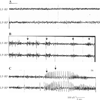Epilepsy in succinic semialdehyde dehydrogenase deficiency, a disorder of GABA metabolism
- PMID: 21664777
- PMCID: PMC4385391
- DOI: 10.1016/j.braindev.2011.04.013
Epilepsy in succinic semialdehyde dehydrogenase deficiency, a disorder of GABA metabolism
Abstract
Objectives: Succinic semialdehyde dehydrogenase (SSADH) deficiency is a gamma-aminobutyric acid (GABA) degradative defect. Epilepsy affects half of patients. The murine model is associated with a transition from absence to convulsive seizures in the third week, with fatal status epilepticus.
Methods: The clinical phenotype is reported from a patient database. Flumazenil-Positron Emission Topography (FMZ-PET) and Transcranial Magnetic Stimulation (TMS) were used to study GABA neurotransmission. Electrocorticography, single cell electrophysiology, and radioligand binding studies are reported from animal studies.
Results: Generalized seizures predominate, including tonic-clonic, atypical absence, and myoclonic. EEG discharges are typically generalized spike-wave. MRI shows a dentatopallidoluysian pattern. Sudden Unexpected Death in Epilepsy Patients (SUDEP) has occurred and the associated neuropathology reveals chronic excitotoxic injury in gloubus pallidus. Investigations using FMZ-PET and TMS support downregulation of GABA(A) and GABA(B) activity, respectively, in patients. Gamma-hydroxybutyrate (GHB) induces spike-wave discharges in homozygous null mice via GHB and GABA(B)-mediated mechanisms. These resemble absence seizures and are abolished by a GABA(B) receptor antagonist. Decreased binding of GABA(A) and GABA(B) receptor antagonists has been demonstrated in P19 and P14 null mice, respectively. Downregulation of GABA(A) and GABA(B) receptor subunits is observed by P14. GABA(A) and GABA(B) mediated potentials are reduced from P8-P14.
Conclusion: Generalized epilepsy and epileptiform discharges are characteristic of SSADH deficiency. Spontaneous absence seizures appear in null mice by the third week, which may be induced by GHB or GABA(B) activity. Subsequent overuse dependent downregulation of GABA(A) and GABA(B) receptor activity may be associated with hyperexcitability concomitant with the transition to generalized seizures.
Copyright © 2011 The Japanese Society of Child Neurology. Published by Elsevier B.V. All rights reserved.
Figures






References
-
- Pearl PL, Gibson KM, Acosta MT, Vezina LG, Theodore WH, Rogawski MA, et al. Clinical spectrum of succinic semialdehyde dehydrogenase deficiency. Neurology. 2003;60:1413–1417. - PubMed
-
- Cortez MA, Wu Y, Gibson KM, Snead OC., 3rd Absence seizures in succinic semialdehyde dehydrogenase deficient mice: a model of juvenile absence epilepsy. Pharmacol Biochem Behav. 2004;79:547–553. - PubMed
-
- Pearl PL, Gibson KM. Clinical aspects of the disorders of GABA metabolism in children. Curr Opin Neurol. 2004;17:107–113. - PubMed
-
- Pearl PL, Capp PK, Novotny EJ, Gibson KM. Inherited disorders of neurotransmitters in children and adults. Clin Biochem. 2005;38:1051–1058. - PubMed
Publication types
MeSH terms
Substances
Grants and funding
LinkOut - more resources
Full Text Sources
Medical
Research Materials

